The new media reality, whereby businesses have the ability to be media as well, has led to some new types of media that are increasingly converging. Although in reality definitions such as content marketing, inbound marketing, outbound marketing, social media marketing on one hand and the different types of media overlap and integration is key, it’s interesting to understand these definitions.
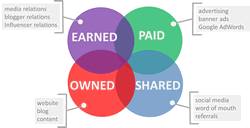
While we have split these different kinds of media in the past (and it’s often still done), there is a convergence going on as you can read below. In reality, however, there always was a de facto overlap and with “converged media” this overlap gets increasingly stressed, especially as content marketing is heading towards an approach whereby topics such as branded content, “native advertising” etc. become more important in the industry.
From paid and earned media to converged media
In the past, we only used paid and earned media. With the advent of the Web, we used more earned media and when blogs and social media popped up, we also started talking about “owned media” and “shared media“. It became even more important when brands started to realize they could “act as publishers”, one of those clichés in content marketing.
David Armano tackled the topic of social and owned/earned/paid in 2010 in his blog post “Why PR’s Future May Not Look Like PR“, visualizing the evolutions happening in those days, with the advent of social media, in the graphic below. Since then, there have been more changes as you can read further in this article.
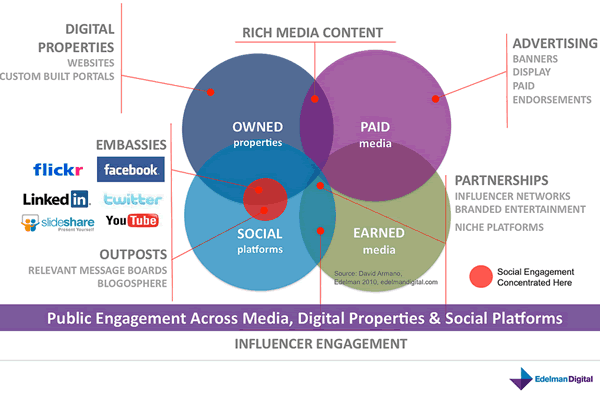
The 5 types of media as they are used now:
- Paid media essentially was (and still is) advertising such as magazine advertising, sponsored initiatives, display ads, PPC ads etc.
- Earned media essentially was/is PR – now with a 2.0 twist: the coverage you get as a result of public, media and today also blogger and influencer relations efforts.
- Owned media is what you “control” and create: from blogs and your website to papers etc. It’s an area where content marketing focuses on a lot.
- Shared media, although very overlapping with the other 3, revolves around shared content, word of mouth, referrals, community-driven content, co-creation, etc. This is an area where both content marketing and social media marketing come into play.
- Converged media. A fifth category is so-called converged media, a term introduced by Altimeter group (see below). Essentially, it simply means combining and integrating the four categories again (and taking some recent evolutions into account).
This convergence is quite obvious as de facto there are already many overlaps between the different media and in audience-centric or customer-centric view it’s less about the media and more about the integration of channels and tactics. So, in the end, nothing really new for the holistic-thinking marketer.
A healthy mix of media is always necessary, depending on your goals and audiences. Different types of media and efforts should strengthen each other’s impact. Note that, although owned media typically have a lower cost per lead, to use just one metric, they are not a free lunch. You don’t have to pay the media but owned media, just as all other forms of media, of course take effort and thus have a cost. A smart mix of channels and media does not only aim to strengthen overall impact, it also aims to keep costs lower.
Forrester’s Sean Corcoran gave a more detailed overview of owned media, paid media and earned media in the chart below, when writing about it in 2009.
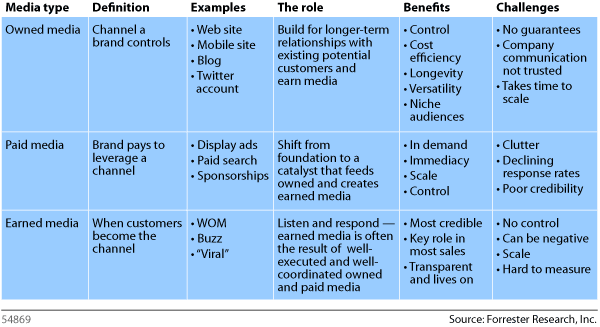
And, on the Pear Analytics blog you can find an example of a marketing plan with paid, owned, earned and shared media.
Converged media: the branded content evolutions
A smart mix revolves around the different touchpoints in the customer journey, brand experience touchpoints, customer/audience intent and stages in the customer life cycle. Easy, although media proliferation made it look harder. Furthermore, it’s mainly the number of touchpoints that has grown.
As mentioned, there is a convergence of the different types of media. This was well described in an Altimeter Group report, written by Rebecca Lieb, Jeremiah Owyang, Jessica Groopman and Chris Silva, shedding more light on the evolutions in these areas, mainly from a media and content marketing perspective. It’s called “The Converged Media Imperative: How Brands Must Combine Paid, Owned, and Earned Media.”
In the report, Altimeter describes the dynamic customer journey and the convergence of three types of media: paid, owned and earned. The report also stresses that no single medium can stand alone.
Customer-centric marketers know the only approach that works is an integrated one that of course is about a dynamic customer journey. The customer journey has always been dynamic, cross-channel and non-linear. In recent years, it only became clearer. Funnel models are models, not reflections of the customer journey reality. Furthermore, it’s not only about channel or media integration. It’s simply about a digital marketing or business strategy, which by definition should be integrated.
No medium or channel should be disconnected. That’s the very essence of marketing and what we know as a mix. It’s also the essence of a customer-centric instead of channel-oriented view. We are not the center of the universe and our content, media and channels are merely servants of business goals, the customer journey and relevance as a way to revenue. The convergence of paid, owned and earned media is a natural evolution.
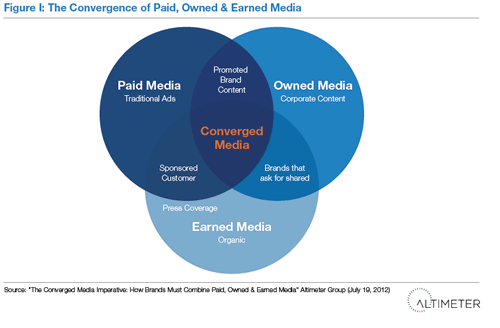
Converged media: paid, owned and earned media with a twist
The report is interesting and describes “Converged Media” as “utilizing two or more channels of paid, earned, and owned media…characterized by a consistent storyline, look, and feel…(whereby)…all channels work in concert, enabling brands to reach customers exactly where, how, and when they want, regardless of channel, medium, or device, online or offline“.
Altimeter does a great job at reminding us that a campaign-focused mindset can be as suffocating as a channel-focused one. Obviously, every ingredient and channel matters but they have to work in concert and across the silos that still exist in so many businesses. The report further demystifies this artificial separation of paid, owned and earned media by emphasizing that so-called consumer media, advertising and corporate content as co-author Jeremiah Owyang writes, indeed converge into one media type.
This is not about being unclear regarding advertising. It’s about acknowledging the integration that already happens (e.g. ads with reviews). That’s a challenge for agencies and their existing revenue models (aligning agencies and vendors is one of the success criteria).
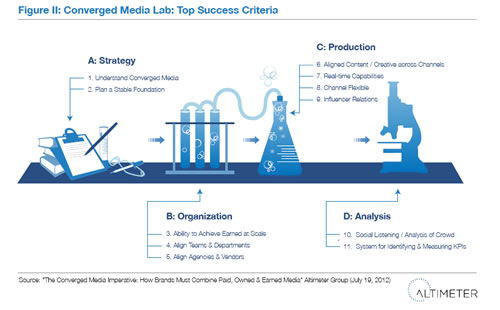
Beyond paid, owned and earned media: experiences and integration
Media convergence, to us, is also about the integration and cross-fertilization underlying it, with the customer (experience) in the middle. If you really know what customer-centric marketing – and relevant advertising – is about and have understood that it’s not about media but about experiences, touchpoints and conversions (including social ones), integration should not be new. In case it is, I urge you to start thinking about marketing from a holistic and touch point oriented viewpoint.
In general, it strikes us that we often talk about integration and the customer journey as the shiny new thing. Why is that? Just two considerations.
- The rediscovery of B2B marketing
Although we like to say B2B marketing and B2C marketing are dead and replaced by people-to-people marketing or whatever term we use, there always have been and still are differences between both. In B2B marketing often a more personal approach, in tune with the customer journey was (and still is) possible. What we are witnessing for several years now is the ‘discovery’ or ‘entrance’ of proven B2B marketing strategies in B2C environments. Hence the fact we often tend to reinvent the wheel. - Silos are not a generational thing.
Younger generations that grew up with social media, Web 2.0 and whatnot, were as focused on media (and channels) as – admit it – many of their older peers. The absurd obsession with media, channels and, in the end, platforms, such as Facebook, was looked upon from the medium perspective from day one. The same silos we have been fighting for ages and the Altimeter report advises us to fight as well, have been strengthened by a whole new breed of marketers that learned nothing from the past. As said, in a way even the distinction between paid, owned and earned media was an artificial one. It’s nice to see that Altimeter recognizes this when writing “outlying channels don’t neatly conform to the categories of paid/owned/earned media” and mentioning hybrid media.
Channels and media matter. Integration as well. However, what should drive you every single day is the customer experience and every little touchpoint – regardless of media and channels – that constitutes it. If you haven’t done that yet, focusing on relevance and a measured approach from the customer journey perspective, you are years behind leading businesses that are doing it with success since ages.
Good marketing is by definition integrated. What more do we need to finally understand that?
The report is a way to start from the media perspective and provides good interviews, strategic considerations and key success factors (see figure II). It also contains an overview of some players in the converged media vendor ecosystem (yes, it’s about applications as well).
Read it and think even further and beyond media convergence or converged media. Think customer experience, preferences, intent and touchpoints too.

